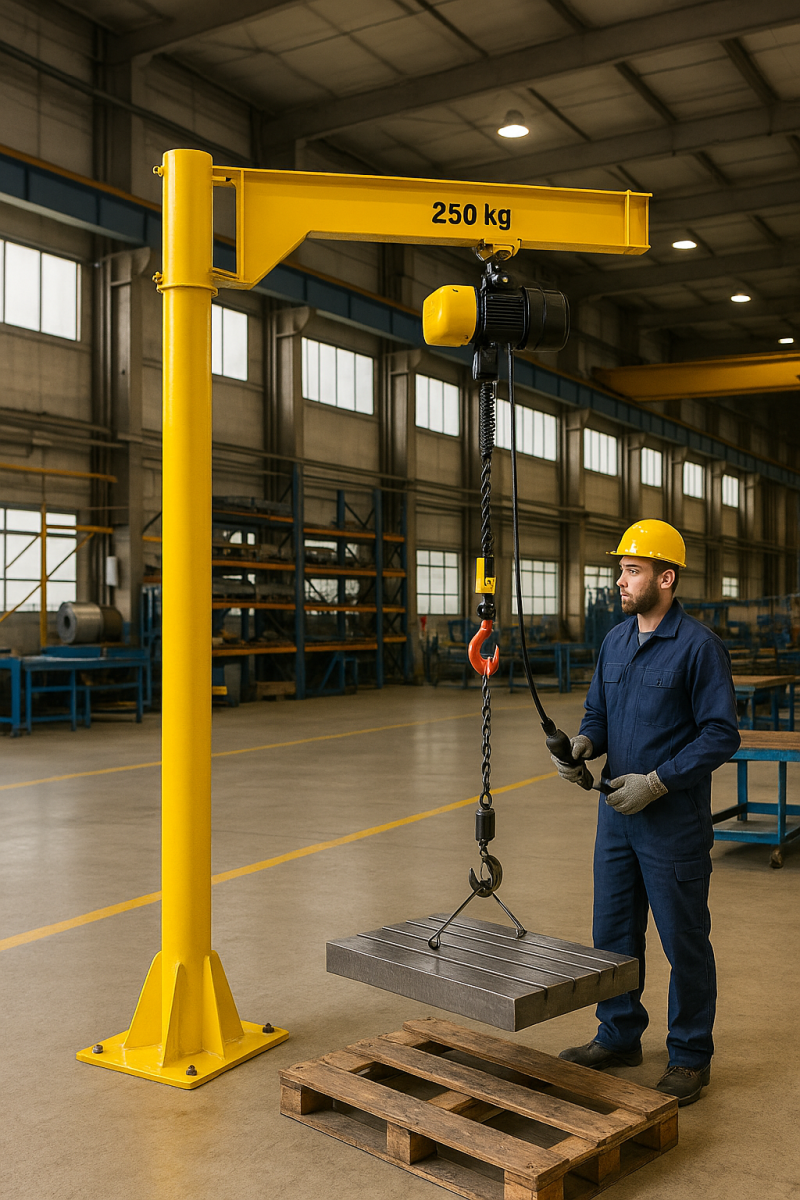



With automation, they’ve evolved into intelligent systems that enhance productivity, safety, and precision in material handling. But implementing an automated jib crane system requires a well-defined step-by-step process.
Whether you’re installing a freestanding jib crane, integrating a wall mounted jib crane, or upgrading to a smart articulating system, this guide outlines the essential steps you need to follow for successful implementation.
Not sure what the basic purpose is? Start with what is a jib crane used for to understand their foundational role in modern operations.

Before choosing automation, define the key performance indicators (KPIs) and use cases:
What type of loads will be lifted?
How often will lifts occur?
Is precision placement required?
Will the crane operate independently or as part of an automated production line?
These questions determine whether a ceiling mounted jib crane or an articulating jib crane with smart sensors is more suitable for your operation.
For detailed classifications, check out what are jib crane types.
Not all jib cranes are equally suited for automation. Here’s a breakdown:
Freestanding Jib Crane: Offers 360° rotation and is excellent for central work areas.
Wall Mounted Jib Crane: Great for saving floor space and integrating into workstation layouts.
Ceiling Mounted Jib Crane: Keeps the floor clear and integrates with overhead systems.
Articulating Jib Crane: Best for working around obstacles and offering multi-axis movement.
Pillar Jib Crane: Compact for light-duty use but limited in reach and load.
Compare this with traditional options in Jib cranes and overhead cranes solutions.
Every site has different limitations:
Floor thickness and reinforcement (for freestanding cranes)
Wall strength (for wall-mounted variants)
Ceiling beams and trusses (for overhead installations)
Also, assess:
Load weight and size
Frequency of lifts
Required working radius and lifting height
Safety clearances and obstacles

Automated jib cranes typically include:
Motorized trolleys and hoists
Programmable logic controllers (PLCs)
Load detection sensors
Collision avoidance systems
Remote control or app-based interfaces
Depending on your application, you might also need:
Zone limiters
IoT connectivity for data logging
Integration with WMS or ERP platforms
Need step-by-step technical help? Read how to build a jib crane.
Each jib crane type requires a different foundation:
Freestanding units: Concrete pads with anchor bolts
Wall-mounted types: Load-bearing walls or columns
Ceiling-mounted types: Steel beams rated for dynamic loads
If you're designing for a wall-mounted unit, see this live product guide: How to build a jib crane wall-mounted.
Installation must follow manufacturer guidelines and usually includes:
Assembling base, mast, and boom
Aligning and leveling the crane
Installing the hoist and trolley systems
Wiring control panels and motors
Setting up PLC parameters and automation logic
Safety testing and load verification
Some systems include plug-and-play automation kits, but others may require engineering support.
For field-tested installation tips, check how to apply a jib crane wall-mounted.
No automation system is effective without properly trained staff. Training should include:
How to use the remote control or HMI panel
Interpreting sensor alerts and system warnings
Emergency stop procedures
Daily and weekly maintenance routines
Consider certification where applicable, especially in facilities governed by ISO, OSHA, or local safety standards.

To maximize your ROI, the automated jib crane must be integrated with existing processes. That may include:
Material tracking systems
Automated conveyors
Pick-and-place robots
Maintenance tracking dashboards
Monitor KPIs such as:
Lift frequency and cycle times
Downtime incidents
Maintenance alerts and fault codes
Operator efficiency and safety compliance
Explore how these elements are evolving in How Automation Transforms Jib Crane Functionality.
Automation introduces more electronics, which require scheduled checks:
Weekly inspections of wiring, hoists, and sensors
Monthly lubrication and load testing
Quarterly software updates and diagnostics
Annual structural audits
Predictive maintenance systems can automate alerts based on usage data.
When you automate a jib crane, think beyond your current needs. Consider:
Adding additional cranes with shared control units
Integrating machine vision for AI-based load tracking
Expanding sensor systems to detect wear and corrosion
This scalability ensures your investment continues to deliver value as your operation grows.

Implementing an automated jib crane involves more than simply choosing a crane model—it’s a strategic process. From evaluating the workspace and selecting the right crane type to automating movement and integrating with your digital systems, each step is vital.
If you're at the beginning of this journey, first understand what is a jib crane used for. Then explore your ideal solution, from structural types to control systems.
With careful planning and step-by-step execution, your smart jib crane will become a cornerstone of operational efficiency and workplace safety.
References
1. How to operate a Jib Cranes safely
3. Over brace jib crane wall mounted
5. Is a Jib Crane a Gantry Crane
6. Articulated Jib Crane Wall Mounted
8. Manual Counterbalance Crane
10. Over Braced Jib Crane Column Mounted
Sign up to receive the latest info on new Aardwolf products, special offers and more.
By signing up you agree to receive emails from Aardwolf with news, special offers, promotions and other information. You can unsubscribe at any time.